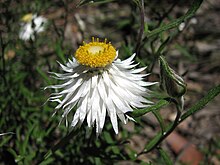| Satin everlasting | |
|---|---|

| |
| Helichrysum leucopsideum near Walhalla, Victoria | |
| Scientific classification | |
| Kingdom: | Plantae |
| Clade: | Tracheophytes |
| Clade: | Angiosperms |
| Clade: | Eudicots |
| Clade: | Asterids |
| Order: | Asterales |
| Family: | Asteraceae |
| Genus: | Helichrysum |
| Species: | H. leucopsideum |
| Binomial name | |
| Helichrysum leucopsideum DC. | |
| Synonyms | |
|
Gnaphalium leucopsideum Labill. | |
Helichrysum leucopsideum, commonly known as satin everlasting, is a flowering, perennial herb in the family Asteraceae. It is grows in all states of Australia except Queensland and the Northern Territory. It has white, terminal flower heads and narrow, woolly leaves.
Description
Helichrysum leucopsideum is an upright, spreading perennial herb 15–50 cm (5.9–19.7 in) high, stems with occasional or thickly woolly glandular hairs. The leaves are narrowly oblong to linear, 1.5–5 cm (0.59–1.97 in) long, 1–10 mm (0.039–0.394 in) wide, blunt to acute and ending with a sharp point. The upper surface green, rough, hairless or with a few scattered glandular hairs. The lower surface grey or white, densely woolly and the margins rolled under or wavy. The flower heads are mostly single or 2-3 in corymbs, 2–3.5 cm (0.79–1.38 in) in diameter and the bracts are arranged in rows of about 10, white, sometimes pinkish in bud, wooly toward the base, folding back toward the stem as the flower matures, florets are yellow and numerous. Flowering occurs mostly in spring and summer and the fruit is cypsela 2–3 mm (0.079–0.118 in) long, smooth, brown and bristly.
Taxonomy and naming
Helichrysum leucopsideum was first formally described in 1838 by Augustin Pyramus de Candolle and the description was published in Prodromus Systematis Naturalis Regni Vegetabilis. The specific epithet (leucopsideum) refers to the white bracts surrounding the disc florets.
Distribution and habitat
Satin everlasting grows in a variety of habitats including sand, open forests, coastal scrub to sub-alpine locations in Western Australia, South Australia, Victoria, Tasmania and New South Wales.
References
- "Helichrysum leucopsideum". Australian Plant Census. Retrieved 3 June 2023.
- ^ Everett, J. "New South Wales Flora Online: Helichrysum leucopsideum". Royal Botanic Gardens & Domain Trust, Sydney, Australia.
- ^ "Helichrysum leucopsideum". VICFLORA-Flora of Victoria. Royal Botanic Gardens Victoria.
- Schaumann, M.; Barker, J.; Grieg, J. (1987). Australian Daisies. Sydney: Lothian Publishing. p. 138. ISBN 0850912911.
- ^ Everett, J. "Helichrysum leucopsideum". PLANTNET-NSW Flora online. Royal Botanic Gardens Sydney. Retrieved 4 June 2023.
- de Candolle, Augustin Pyramus (1838). Prodromus Systematis Naturalis Regni Vegetabilis. Paris. p. 193. Retrieved 5 June 2023.
- "Helichrysum leucopsideum". Australian Plant Name Index. Retrieved 5 June 2023.
- George, A.S; Sharr, F.A (2021). Western Australian Plant Names and their meanings (4th ed.). Kardinya: Four Gables. p. 246. ISBN 9780958034197.